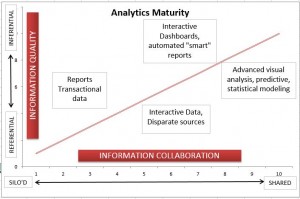uhhh…. In a nutshell it’s driven by data variety. (Not just the composition of data but also varied sources)
But what does that look like? Let’s say in Company “A” the sales department would like to analyze some sales data on Product “X”. OK easy right? you pull a (insert data source here) shipment report, pick some date ranges, and run your report. But now a spike in a given time frame prompts some additional questions… Why did that happen? What drove the increase? How does that compare to last year, last quarter, last period? Was it one or more sales divisions, customers, geographical areas? and the “WHY’s” create an avalanche that leads to… WE NEED MORE DATA!!!!!
Marketing suggests running a media spend report for some correlation to advertising activity. Someone else prompts looking at retail sales for the identified product across your re-sellers or retailers. Your Social Media team wants to contribute data on FB “Likes”, Engagement, customer digital behavior, and NOW it’s gets interesting… different departments, different systems, different data formats, different report layouts, different data outputs (csv, pdf, xls, mht) and on and on and on. Plus you now have different business stakeholders all with a slightly different “end game” in mind with regards to the business insight objective.
Is everyone seeing what’s different?
Here is one of my favorites… you have some key metrics you’d like to plot across time on a line graph. However, for each metric (on each report) the date is different in both format and frequency. Your sales report is weekly i.e. w/ending x/xx/xxxx. Your finance report is monthly Month/Yr. Your Social Media report is daily Mon xx/xx/xxxx. Your shipment report is weekly but the format is week end Mnth/Yr XX:xx 00 sec AM/PM. Remember you just wanted to compare some values across time, apply a little business intuition and make some fact based recommendations. Now your tasked with somehow becoming an overnight data scientist with a little shared time on the CRAY super computer.
And so this plays out week after week from front line administrators, mid-level managers, analysts and executives. Each wanting actionable insight backed by data, analysis and confidence. There are some free on-line tools that can help, as long as you don’t mind your results being PUBLIC. There are also a bevy of “drag and drop” analytics tools to choose from and these can provide a degree of relief to situations outlined above.
What’s your favorite example of something starting easy only to get beyond difficult?



